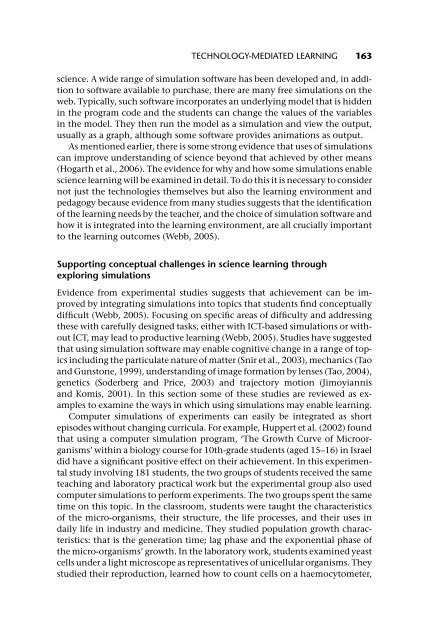good-practice-in-science-teaching-what-research-has-to-say
good-practice-in-science-teaching-what-research-has-to-say
good-practice-in-science-teaching-what-research-has-to-say
Create successful ePaper yourself
Turn your PDF publications into a flip-book with our unique Google optimized e-Paper software.
TECHNOLOGY-MEDIATED LEARNING 163<br />
<strong>science</strong>. A wide range of simulation software <strong>has</strong> been developed and, <strong>in</strong> addition<br />
<strong>to</strong> software available <strong>to</strong> purc<strong>has</strong>e, there are many free simulations on the<br />
web. Typically, such software <strong>in</strong>corporates an underly<strong>in</strong>g model that is hidden<br />
<strong>in</strong> the program code and the students can change the values of the variables<br />
<strong>in</strong> the model. They then run the model as a simulation and view the output,<br />
usually as a graph, although some software provides animations as output.<br />
As mentioned earlier, there is some strong evidence that uses of simulations<br />
can improve understand<strong>in</strong>g of <strong>science</strong> beyond that achieved by other means<br />
(Hogarth et al., 2006). The evidence for why and how some simulations enable<br />
<strong>science</strong> learn<strong>in</strong>g will be exam<strong>in</strong>ed <strong>in</strong> detail. To do this it is necessary <strong>to</strong> consider<br />
not just the technologies themselves but also the learn<strong>in</strong>g environment and<br />
pedagogy because evidence from many studies suggests that the identification<br />
of the learn<strong>in</strong>g needs by the teacher, and the choice of simulation software and<br />
how it is <strong>in</strong>tegrated <strong>in</strong><strong>to</strong> the learn<strong>in</strong>g environment, are all crucially important<br />
<strong>to</strong> the learn<strong>in</strong>g outcomes (Webb, 2005).<br />
Support<strong>in</strong>g conceptual challenges <strong>in</strong> <strong>science</strong> learn<strong>in</strong>g through<br />
explor<strong>in</strong>g simulations<br />
Evidence from experimental studies suggests that achievement can be improved<br />
by <strong>in</strong>tegrat<strong>in</strong>g simulations <strong>in</strong><strong>to</strong> <strong>to</strong>pics that students f<strong>in</strong>d conceptually<br />
difficult (Webb, 2005). Focus<strong>in</strong>g on specific areas of difficulty and address<strong>in</strong>g<br />
these with carefully designed tasks, either with ICT-based simulations or without<br />
ICT, may lead <strong>to</strong> productive learn<strong>in</strong>g (Webb, 2005). Studies have suggested<br />
that us<strong>in</strong>g simulation software may enable cognitive change <strong>in</strong> a range of <strong>to</strong>pics<br />
<strong>in</strong>clud<strong>in</strong>g the particulate nature of matter (Snir et al., 2003), mechanics (Tao<br />
and Guns<strong>to</strong>ne, 1999), understand<strong>in</strong>g of image formation by lenses (Tao, 2004),<br />
genetics (Soderberg and Price, 2003) and trajec<strong>to</strong>ry motion (Jimoyiannis<br />
and Komis, 2001). In this section some of these studies are reviewed as examples<br />
<strong>to</strong> exam<strong>in</strong>e the ways <strong>in</strong> which us<strong>in</strong>g simulations may enable learn<strong>in</strong>g.<br />
Computer simulations of experiments can easily be <strong>in</strong>tegrated as short<br />
episodes without chang<strong>in</strong>g curricula. For example, Huppert et al. (2002) found<br />
that us<strong>in</strong>g a computer simulation program, ‘The Growth Curve of Microorganisms’<br />
with<strong>in</strong> a biology course for 10th-grade students (aged 15–16) <strong>in</strong> Israel<br />
did have a significant positive effect on their achievement. In this experimental<br />
study <strong>in</strong>volv<strong>in</strong>g 181 students, the two groups of students received the same<br />
teach<strong>in</strong>g and labora<strong>to</strong>ry practical work but the experimental group also used<br />
computer simulations <strong>to</strong> perform experiments. The two groups spent the same<br />
time on this <strong>to</strong>pic. In the classroom, students were taught the characteristics<br />
of the micro-organisms, their structure, the life processes, and their uses <strong>in</strong><br />
daily life <strong>in</strong> <strong>in</strong>dustry and medic<strong>in</strong>e. They studied population growth characteristics:<br />
that is the generation time; lag p<strong>has</strong>e and the exponential p<strong>has</strong>e of<br />
the micro-organisms’ growth. In the labora<strong>to</strong>ry work, students exam<strong>in</strong>ed yeast<br />
cells under a light microscope as representatives of unicellular organisms. They<br />
studied their reproduction, learned how <strong>to</strong> count cells on a haemocy<strong>to</strong>meter,


